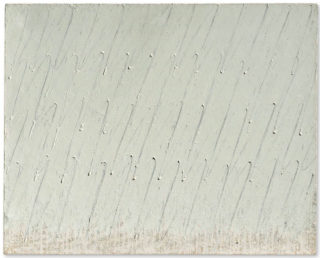Park Seo-Bo (1931 – 2023)
‘My work is related to the oriental tradition of space, the spiritual concept of space. I am more interested in space from the point of view of nature. Even though my paintings may represent an idea about culture, the main focus is based on nature … I want to reduce the idea and emotion in my work to express only that. I want to reduce and reduce – to create pure emptiness. This has been an old value that still exists in oriental philosophy where nature and men are one’ – PARK SEO-BO
‘There is one thing of which I am sure: Park Seo-Bo will go down in history as the great wise man of the all-over. The Korean painter has achieved an original minimalist synthesis that lies between Pollock and Yves Klein’ – PIERRE RESTANY
Translating roughly to ‘monochrome painting’, Dansaekhwa found one of its purest forms of expression in Park’s Écritures. Seeking to transcend the cultural boundaries imposed by military dictatorship during the 1970s, these delicate, gestural visions were among the most influential works to emerge during a period of immense political and sociological change. Along with fellow artists such as Lee Ufan and Yun Hyong-keun, Park sought a new form of abstraction that combined Eastern and Western techniques, media and philosophies. His intuitive linear technique – also known as ‘Myobop’ or ‘law of drawing’ in Korean – sought to eliminate all form of conscious gesture in a bid to channel the natural energies of the flesh and the psyche. In doing so, Park initiated a pioneering cross-cultural dialogue: between contemporary Western artists who viewed line as a metaphysical conduit – most notably Cy Twombly – and the meditative calligraphic traditions of his native Korea.
A pure monochromatic field incised with a lyrical, undulating script, Écriture No. 26-75 is a major early work from Park Seo-Bo’s seminal series of the same name. Tracing his pencil through a thick layer of still-wet paint, the artist carves a sequence of rhythmic, graphic lines, ploughing grooves and furrows into his otherwise blank surface. White paint glimmers in the interstices, punctuating the mottled surface periodically like beams of light. The work stems from 1975: the pivotal year that saw the first Dansaekhwa show outside of Korea. Held at the Tokyo Gallery in Japan, the exhibition showcased Park’s work alongside four of his contemporaries and set the movement on a new international stage.
With its hypnotic, undulating script incised into the surface of the pigment, Park Seo-Bo’s Écriture No. 62-81 is a mesmerising calligraphic vision from his most important series of paintings. Acknowledged by Park as one of the finest of its size, the work’s rippling arabesques epitomise the liberated, meditative aesthetic to which the series aspired. Begun in the late 1960s, the Écritures – or Writings – were among the most iconic and influential works to emerge from the pioneering Dansaekhwa movement.
Executed in a single sitting, each Écriture generates a unique pattern that unfolds to the very edge of the paper. Imbued with infinite potential, Park’s line is described by the artist as a ‘journey of the hand’: a dynamic, naturally-evolving trace born of neuronal and bodily impulse. Deeply inspired by the teachings of Buddhism and Taoism, Park was fascinated by the notion of the artist as a vessel for spiritual and existential truth. ‘I am more interested in space from the point of view of nature’, he explains. ‘…By eliminating all sense of content from his works, Park allowed himself to physically merge with his medium: artist, pencil and surface become inextricable. The paper becomes a living, breathing presence: a temporal plane upon which the inarticulate patterns of consciousness are made visible. This effect is enhanced by Park’s use of white – a dimensionless colour that signifies the immaterial. Unfurling across the paper like a mountain range or a series of cresting waves, Park’s graphic coils transform his vacant landscape into a reservoir of energy and sensation: a projection of nature’s invisible forces. It is an image of the traces and marks left by our existence upon the void. Scarred, rippled and animated by the movements of the universe, the blank abyss of time is – momentarily – made material.

